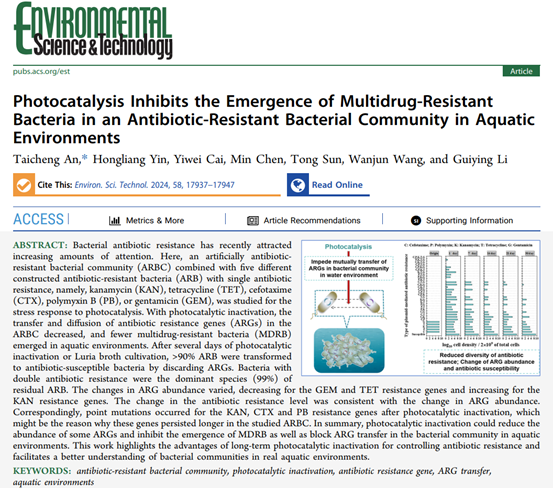近日,广东工业大学环境健康与污染控制研究院、环境科学与工程学院安太成教授团队在光催化消毒技术抑制多重抗生素耐药细菌的滋生方面取得重要进展。研究成果以《Photocatalysis Inhibits the Emergence of Multidrug-Resistant Bacteria in An Antibiotic-Resistant Bacterial Community in Aquatic Environments》为题,于近期发表在Environmental Science & Technology (2024, 58(40),17937-17947)期刊上。论文的第一兼通讯作者为安太成教授,主要作者包括为我院博士毕业生殷洪亮、在站博士后蔡仪威和李桂英教授等,广东工业大学为论文的唯一单位。

论文网址:https://doi.org/10.1021/acs.est.4c06752
近年来,抗生素耐药性的传播逐渐成为了威胁人类健康的全球性问题。本研究通过构建由五种不同单抗生素耐药细菌(ARB)组成的抗生素耐药菌群(ARBC),进一步研究了光催化消毒刺激对于抗生素抗性基因(ARGs)在混合复杂菌群中的传播及其遗传稳定性的影响。随着光催化消毒时间的延长,水环境ARBC中ARGs的转移和扩散逐渐被抑制,多重耐药细菌(MDRB)的多样性和丰度均逐渐降低。经过数天的光催化处理失活或LB培养后,>90%的ARB通过丢弃ARG转化为抗生素敏感菌,而双耐药菌成为残留ARB的优势菌株(99%)。ARG丰度的变化各不相同,其中庆大霉素和四环素抗性基因减少,卡那霉素抗性基因增加。抗生素耐药水平的变化与ARG丰度的变化相一致。相应地,卡那霉素、头孢噻肟和多粘菌素B抗性基因在光催化处理后发生了点突变,这可能是这些ARGs在ARBC中持留时间较长的原因。综上所述,光催化可以降低某些ARG的丰度,从而抑制MDRB的滋生,并阻止ARGs在水生环境细菌群落中的转移与传播。本研究揭示了光催化消毒技术在控制抗生素耐药性方面的优势,并有助于更好地了解真实水生环境中细菌群落中的抗生素耐药性的演化。
英文摘要:
Bacterial antibiotic resistance has recently attracted increasing amounts of attention. Here, an artificially antibiotic-resistant bacterial community (ARBC) combined with five different constructed antibiotic-resistant bacteria (ARB) with single antibiotic resistance, namely, kanamycin (KAN), tetracycline (TET), cefotaxime (CTX), polymyxin (PB), or gentamicin (GEM), was studied for the stress response to photocatalysis. With photocatalytic inactivation, the transfer and diffusion of antibiotic resistance genes (ARGs) in the ARBC decreased, and fewer multidrug-resistant bacteria (MDRB) emerged in the aquatic environment. After several days of photocatalytic inactivation or LB cultivation, >90% ARB were transformed to antibiotic-susceptible bacteria by discarding ARGs. Bacteria with double antibiotic resistance were the dominant species (99%) of residual ARB. The changes in ARG abundance varied, decreasing for the GEM and TET resistance genes and increasing for the KAN resistance genes. The change in the antibiotic resistance level was consistent with the change in ARG abundance. Correspondingly, point mutations occurred for the KAN, CTX and PB resistance genes after photocatalytic inactivation, which might be the reason why these genes persisted longer in the studied ARBC. In summary, photocatalytic inactivation could reduce the abundance of some ARGs and inhibit the emergence of MDRB as well as block ARG transfer in the bacterial community in the aquatic environment. This work highlights the advantages of long-term photocatalytic inactivation for controlling antibiotic resistance and facilitates a better understanding of bacterial communities in real aquatic environments.
项目资助:本研究受到国家自然科学基金项目(42330702,42122056和42407291)和粤桂联合基金重点项目(2020B1515420002)的联合资助。